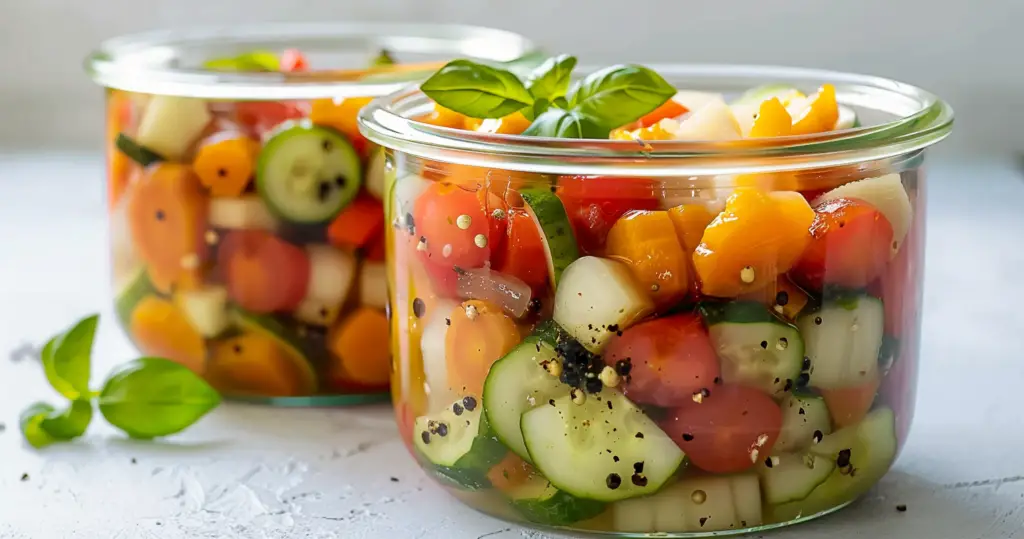Giardiniera is a delightful mix of pickled vegetables that brings vibrant colors and flavors to any dish. This versatile condiment can be used as a topping for sandwiches, pizzas, salads, and antipasto platters. In this article, you will learn everything about making giardiniera, including its history, preparation tips, ingredient lists, step-by-step instructions, and much more.

Overview of Giardiniera
Giardiniera offers a unique blend of tangy, spicy, and savory flavors, making it a perfect addition to a variety of meals. This Italian pickled vegetable mix is not only easy to prepare but also versatile enough to complement many dishes. Whether you are looking for a flavorful condiment or a tasty side dish, giardiniera is an excellent choice.
For more condiment ideas, check out our best condiments and discover other delicious pickled recipes on our website. For further reading, see how to make perfect pickled vegetables and explore the best Italian recipes.
Brief History and Cultural Significance
Giardiniera originated in Italy, where it has been a staple in Italian cuisine for centuries. Traditionally, it was made to preserve summer vegetables for the winter months. The word “giardiniera” means “from the garden,” highlighting the use of fresh, seasonal produce. This pickled vegetable mix has evolved over time and has become popular in various cuisines around the world.
In the United States, giardiniera is especially popular in Chicago, where it is used as a topping for Italian beef sandwiches, hot dogs, and pizzas. This version often includes a spicy kick from hot peppers, making it a favorite among those who enjoy bold flavors. The versatility and rich history of giardiniera make it a beloved condiment in many households.
To explore more about the history and cultural significance of giardiniera, visit our article on Italian culinary traditions.
Preparation Phase & Tools to Use
Recipe details
- Prep Time: 20 minutes
- Cook Time: 10 minutes
- Total Time: 30 minutes
- Servings: 8
- Yield: 4 jars
Essential Tools and Equipment
- Sharp knife
- Cutting board
- Mixing bowls
- Saucepan
- Canning jars with lids
- Tongs
- Thermometer
Importance of Each Tool
Each tool plays a crucial role in ensuring the giardiniera is perfectly prepared and stored. A sharp knife helps in cutting the vegetables evenly, while mixing bowls are essential for combining ingredients. Canning jars are used to store the giardiniera safely, and a thermometer helps in maintaining the correct temperature during the pickling process.
Preparation Tips
- Ensure the vegetables are cut into uniform pieces for even pickling.
- Blanch vegetables like cauliflower and carrots to maintain their crispness.
- Use fresh herbs and spices for the best flavor.
When cutting the vegetables, it is important to keep them uniform in size to ensure they pickle evenly. Blanching certain vegetables helps preserve their texture, while fresh herbs and spices enhance the overall flavor of the giardiniera.
To learn more about the preparation phase and tools needed for giardiniera, check out our detailed guide on pickling essentials.
Ingredients List
- 1 cup cauliflower florets
- 1 cup sliced carrots
- 1 cup sliced celery
- 1 cup sliced bell peppers
- 1 cup pitted green olives
- 4 cloves garlic, peeled and sliced
- 2 Serrano chile peppers, sliced
- 4 bay leaves
- 2 teaspoons dried oregano
- 1 teaspoon celery seeds
- 1 teaspoon fennel seeds
- 1 teaspoon yellow mustard seeds
- 1/2 teaspoon coriander seeds
- 1/4 teaspoon black peppercorns
Brine Ingredients
- 3 cups water
- 3 cups white wine vinegar
- 2 tablespoons salt
- 2 tablespoons sugar
The ingredient list includes a mix of vegetables and spices that create a well-balanced and flavorful giardiniera. The brine is crucial for the pickling process, providing the necessary acidity and saltiness.
Step-by-Step Instructions
- Prepare the Vegetables: Wash and cut all vegetables into uniform pieces. This step ensures even pickling and a consistent texture.
- Blanch the Vegetables: Blanch cauliflower and carrots in boiling water for 2 minutes, then transfer to an ice bath to cool. Blanching helps retain the vegetables’ crispness and vibrant colors.
- Prepare the Brine: Combine water, vinegar, salt, and sugar in a saucepan. Bring to a boil and stir until the salt and sugar are dissolved. The brine is essential for the pickling process, providing the necessary acidity and seasoning.
- Pack the Jars: Distribute the garlic, Serrano peppers, bay leaves, oregano, celery seeds, fennel seeds, mustard seeds, coriander seeds, and black peppercorns evenly among the jars. Add the vegetables, packing them tightly. Proper packing ensures the vegetables stay submerged in the brine and pickle evenly.
- Add the Brine: Pour the hot brine over the vegetables, leaving about 1/2 inch of headspace at the top of each jar. This step ensures the vegetables are fully covered in the brine, which is crucial for preservation and flavor infusion.
- Seal and Cool: Seal the jars with lids and allow them to cool to room temperature before refrigerating. Cooling the jars before refrigerating helps maintain the vegetables’ texture and flavor.
For more detailed pickling techniques, see our guide on how to make perfect pickled vegetables.
Nutritional Information & Health Benefits
Each serving of giardiniera contains approximately:
- Calories: 50
- Fat: 2g
- Protein: 1g
- Carbohydrates: 6g
Giardiniera is low in calories and fat, making it a healthy addition to meals. The pickling process preserves the vitamins and minerals in the vegetables, such as vitamin C, vitamin K, and fiber. Additionally, the probiotics in the vinegar brine can support gut health.
Using an assortment of vegetables ensures a wide range of nutrients. For those seeking a lower sodium option, consider reducing the amount of salt in the brine. This versatile condiment can enhance the nutritional profile of many dishes.
Common Mistakes to Avoid & How to Perfect the Recipe
- Overcooking the Vegetables: Blanching vegetables for too long can make them too soft. Aim for a quick blanch to retain crispness.
- Inconsistent Slicing: Ensure all vegetables are cut into similar sizes for even pickling.
- Improper Sealing: Make sure the jars are properly sealed to prevent spoilage.
- Skipping the Cooling Step: Allow the giardiniera to cool completely before refrigerating to ensure the best texture and flavor.
To achieve the best results, avoid these common mistakes. Blanching for the correct amount of time preserves the texture of the vegetables, while consistent slicing ensures they pickle evenly. Properly sealing the jars prevents contamination, and cooling the giardiniera before refrigerating helps maintain its crispness.
Tips, Notes, Storing, and Reheating
- Tips and Notes: Use high-quality vinegar for the best flavor. Experiment with different vegetable combinations and spice levels to suit your taste.
- Storing: Store giardiniera in an airtight container in the refrigerator for up to 2 weeks. For longer storage, consider canning.
- Reheating: Giardiniera is typically served cold or at room temperature, so reheating is not necessary. However, it can be used as an ingredient in hot dishes.
To ensure your giardiniera stays fresh, always use clean utensils when serving. For a milder flavor, reduce the amount of hot peppers. To add more variety, try incorporating seasonal vegetables.


Leave a Comment